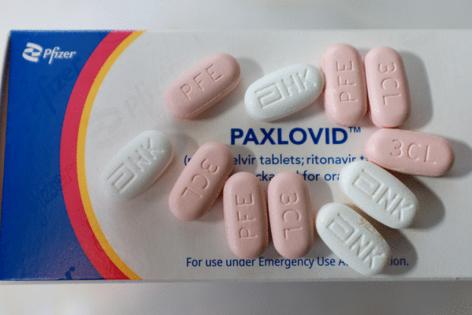The best treatment for COVID is still too hard to get
Published in Health & Fitness
We’re still asking people with COVID to jump through far too many hoops to get their hands on Pfizer Inc.’s Paxlovid.
I experienced the barriers first-hand this month after my mother texted to say that this summer’s COVID wave had finally caught up with her. My first thought was to make sure she quickly started taking the antiviral. You’d think she would be an ideal candidate, because she is in her 70s with an underlying health condition. But it took a daylong effort to get her the medicine, one that involved multiple emails, phone calls with three different doctor’s offices, a telehealth visit and a bit of pharmacy-hopping to find one that had the pills in stock.
“That’s not an uncommon story,” says Amesh Adalja, a senior scholar at the Johns Hopkins Center for Health Security. “There are a lot of misconceptions out there that have undermined the use [of antivirals] from the very beginning.”
The data bear this out. One small study published in early 2024 by the Centers for Disease Control and Prevention found that 4 out of 5 high-risk patients were not offered an antiviral by their doctors. Worse, one large, community-based study found that Black and Latino patients were far less likely to receive the drug than White patients.
It shouldn’t be that way. And the delay matters: Pfizer’s antiviral only helps if taken within the first five days of symptoms. My mom, feverish and exhausted, told me that if I hadn’t stepped in as her advocate, she would have given up.
Doctors must do better, especially as we continue to live through a wave of infections.
Some health care providers may be worried about managing the interactions between Paxlovid and other medicines (my mom, for example, had to pause her Lipitor while on the antiviral). Others have been dissuaded by reports of rebound infections occurring in people who take Paxlovid — despite evidence that the drug’s benefits outweigh those risks in the most vulnerable patients. And some doctors might be operating under perverse incentives that make it more lucrative to have a sick patient make an appointment to confirm their infection instead of simply calling the prescription into a pharmacy after an at-home test.
There’s also lingering confusion about the right candidates for the drug. Paxlovid was authorized in 2021 based on compelling data showing it could keep high-risk unvaccinated people out of the hospital. Yet some doctors don’t seem aware that vaccinated patients can also benefit from it, particularly if they are higher risk. That’s everyone over age 65, or those who are immunocompromised, pregnant or with an underlying condition. Those groups still are at risk of hospitalization and even of dying, especially if their last exposure or booster is in the distant past.
And that’s a lot of people. Only 1 out of every 3 retirement-age adults got last year’s booster. “From my experience as well as others, pretty much everybody I’ve taken care of hasn’t received a vaccine in the last year or so, even though they might have had them originally,” says Peter Chin-Hong, an infectious disease specialist at the University of California, San Francisco. Since mid-August, COVID deaths in the U.S. have been hovering near 1,000 per week, according to CDC data. Shouldn’t we better deploy the tools that might prevent such losses?
Cost shouldn’t be a barrier. When antivirals transitioned to the commercial market last year, the U.S. government partnered with Pfizer to ensure people with public health insurance or without insurance could still get the drugs for free, and minimize the cost for people with private insurance. Yet infectious disease doctors tell me that months into the rollout, too few patients, prescribers and pharmacists seem aware of the program.
True, Paxlovid isn’t perfect. In people who aren’t high-risk, the data are mixed as to whether it helps much (though anecdotes abound for people who say they have felt better faster after taking it). And while there had been much hope that Paxlovid could prevent long COVID, so far the data supporting that hypothesis are inconclusive.
So there’s a clear need for better anti-COVID drugs. Even for young, healthy people who have been jabbed and infected multiple times, an infection can be extremely disruptive, sidelining us from work or school and ruining our best-laid plans. A drug more akin to Tamiflu — a very safe and tolerable treatment for the flu that allows people to bounce back faster, even if only by a day or two — would be a welcome invention.
Yet better antivirals have been slow to arrive. Pfizer is studying a treatment that works similarly to Paxlovid, but doesn’t interact with other medications. And hopes were dashed last spring when Shionogi’s Ensitrelvir, an antiviral approved in Japan, failed to prove it could alleviate symptoms faster than a placebo.
But even if a drug for the masses eventually made it to market, would it be used? When doctors can’t get it right for the most vulnerable, the prospects seem dim.
____
This column does not necessarily reflect the opinion of the editorial board or Bloomberg LP and its owners.
Lisa Jarvis is a Bloomberg Opinion columnist covering biotech, health care and the pharmaceutical industry. Previously, she was executive editor of Chemical & Engineering News.
©2024 Bloomberg L.P. Visit bloomberg.com/opinion. Distributed by Tribune Content Agency, LLC.










Comments